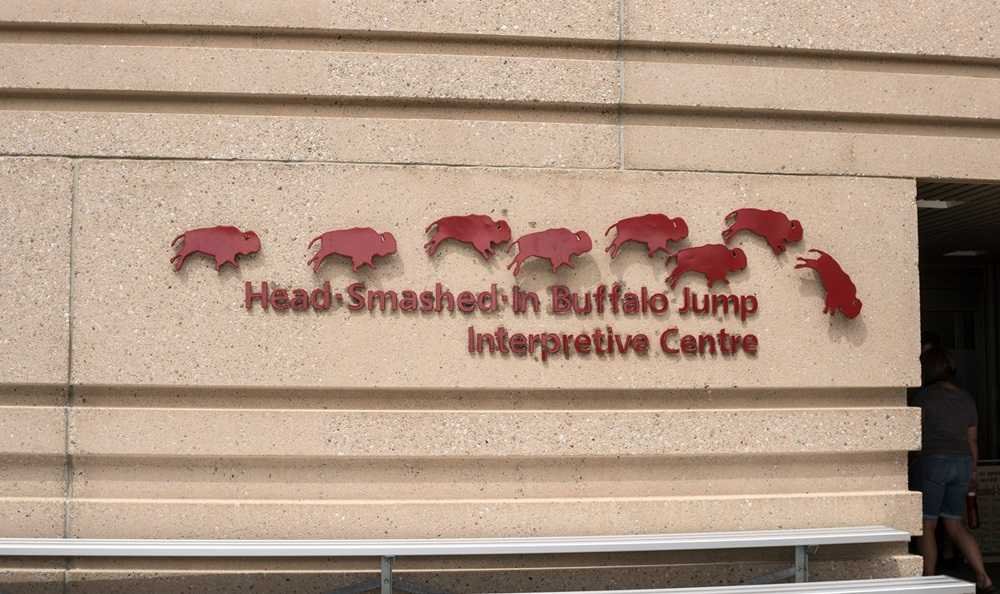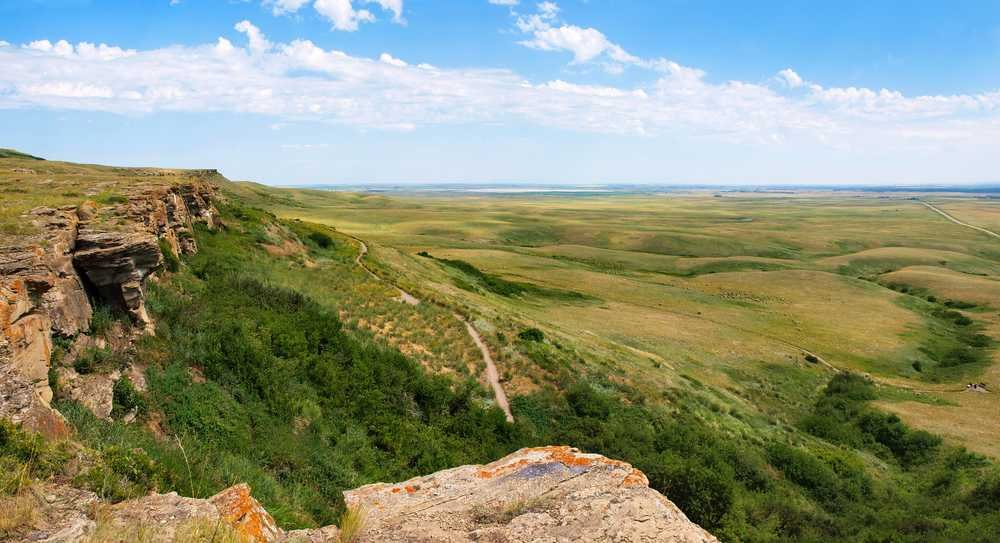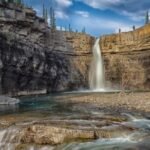Imagine standing on a cliff where, thousands of years ago, Indigenous hunters used a brilliant technique to drive buffalo over the edge. This isn’t just any cliff—this is Head-Smashed-In Buffalo Jump, a place where history and nature come together in a dramatic way. The name itself comes from a powerful Blackfoot legend. According to the story, a young Blackfoot boy wanted to watch the buffalo fall from the cliff up close, standing beneath them. However, as the massive animals plunged down, he was tragically buried under the pile of carcasses, and when they found him, his head had been crushed—thus, the name “Head-Smashed-In.”
 Pin
PinBrief Overview of Head-Smashed-In Buffalo Jump
Head-Smashed-In Buffalo Jump is a UNESCO World Heritage Site located in Alberta, Canada. It’s not only a stunning natural landmark but also a place of deep cultural significance for the Plains Indigenous peoples, especially the Blackfoot Nation. The site tells the story of a time when buffalo were essential to survival, and how the people of the Plains used the landscape in ingenious ways to hunt them. Today, it stands as a powerful reminder of the rich traditions and history of the Indigenous peoples of North America.
Historical and Cultural Significance
Head-Smashed-In Buffalo Jump holds a profound connection to the Plains Indigenous peoples, particularly the Blackfoot Nation, serving as a vital site for survival, community, and tradition for thousands of years.
This location, where the Blackfoot and other tribes relied on buffalo for essential resources like food and clothing, demonstrates their deep understanding of the land. The site was used for over 6,000 years, it employed a sophisticated hunting method where Indigenous peoples drove buffalo herds toward a cliff, showcasing strong community bonds and teamwork.
Recognized globally for its cultural significance, it was designated a UNESCO World Heritage Site in 1981, to celebrate its status as one of the best-preserved examples of a buffalo jump, which is essential to the cultural identity and survival of the Plains Indigenous peoples.
Getting There
Location: Head-Smashed-In Buffalo Jump is located in southern Alberta, Canada. It’s about 18 kilometres northwest of the town of Fort Macleod, which is the closest town. If you’re coming from a larger city, Lethbridge is about 45 minutes away by car, while Calgary is roughly 160 kilometres to the north, about a two-hour drive. The site is situated in a beautiful rural area that offers stunning views of the surrounding prairies and the Rocky Mountains in the distance.
Directions and Transportation: Getting to Head-Smashed-In Buffalo Jump is easy if you’re driving. From Calgary, take Highway 2 south towards Fort Macleod. Once you reach Fort Macleod, you’ll need to take Highway 785 west for about 15 minutes, and you’ll see signs leading you to the site. If you’re coming from Lethbridge, take Highway 3 west towards Fort Macleod, then follow the signs to Highway 785.
Public transportation options are limited, so it’s best to have your own vehicle. However, if you’re visiting from Calgary or Lethbridge, you might find guided tours that include transportation as part of the package. The distance from Calgary is about 160 kilometres, while Lethbridge is closer, at approximately 50 kilometres.
Best Time to Visit Head-Smashed-In Buffalo Jump
The best time to visit Head-Smashed-In Buffalo Jump is during the warmer months, from May to September. During this time, the weather is mild, and the landscape is at its most beautiful, with green prairies and clear skies. July and August are the peak tourist months, so if you prefer fewer crowds, consider visiting in May, June, or September. Early morning or late afternoon visits are ideal for avoiding the midday heat and for catching the best light for photography. Keep in mind that the site is open year-round, but some services may be limited in the off-season.
Head-Smashed-In Buffalo Jump Images
Other Information
Hours of Operation: When I visited Head-Smashed-In Buffalo Jump, I made sure to check the hours beforehand. The Interpretive Centre is open year-round, with hours varying depending on the season. From May to September, the Centre typically operates from 10:00 AM to 5:00 PM daily, which is perfect for planning a day trip. During the quieter months, from October to April, the hours may be reduced, so it’s always a good idea to double-check the current schedule before you go.
Admission Fees: The cost to enter Head-Smashed-In Buffalo Jump is quite reasonable, making it accessible for families and groups. As of 2024, the admission fees are around $15 for adults. Seniors (65 and over) and students with valid ID can enter for a discounted rate of $12.50. For children aged 7-17, the fee is about $9, and kids under 7 get in for free. They also offer family rates and group discounts, so if you’re visiting with a group of friends or family, it’s worth looking into these options to save a bit of money.
Facilities: The site is well-equipped with facilities to make your visit comfortable. There are clean restrooms available at the Interpretive Centre, which is always a relief after a long drive. If you’re planning to spend a few hours exploring, you’ll find picnic areas where you can sit down and enjoy a packed lunch with a view of the prairies. While there isn’t a full-service restaurant on-site, there’s a small café in the Interpretive Centre where you can grab a snack or a drink. If you’re looking for more dining options, Fort Macleod is nearby and offers several restaurants where you can enjoy a meal after your visit.
 Pin
PinVisitor Experience
Interpretive Centre: When you visit Head-Smashed-In Buffalo Jump, the Interpretive Centre is the perfect place to start. This award-winning centre offers a deep dive into the history and culture of the Plains Indigenous peoples. You’ll find five levels of exhibits that explain how the buffalo jump was used, showcasing artifacts, life-sized displays, and interactive exhibits. Educational programs are available for visitors of all ages, and they often include cultural demonstrations such as traditional drumming, dancing, and storytelling. With over 65,000 visitors each year, the Interpretive Centre provides an engaging and informative experience that brings the history of the Buffalo Jump to life.
Guided Tours: I decided to join a guided tour when I visited, and it made all the difference. The guide was incredibly knowledgeable and brought the history of the site to life. They shared fascinating stories and historical facts that I wouldn’t have learned on my own. For instance, the guide explained how the buffalo jump was more than just a hunting technique—it was a critical part of the Plains Indigenous people’s way of life, deeply tied to their culture and survival.
One of the highlights for me was getting special access to areas that aren’t as easily explored on your own. The guide took us to viewpoints and explained the significance of each spot, offering a much deeper understanding of the site. The tour made my visit so much more meaningful, and I left with a richer appreciation for the history and culture preserved at Head-Smashed-In Buffalo Jump.
Self-Guided Exploration: If you prefer to explore at your own pace, self-guided exploration is a great option. The Interpretive Centre provides maps and information to help you navigate the site. Must-see exhibits include the dioramas that depict the buffalo jump in action and the archaeological displays that showcase artifacts found at the site. Don’t miss the stunning viewpoints overlooking the cliff—these spots offer breathtaking views and a real sense of the scale of the Buffalo Jump. Make sure to bring a camera, as the natural landscape and historic features provide excellent photo opportunities.
More to love:
- The Best Guide to The Alberta Badlands
- The Best Time to Visit Alberta, Canada in 2024
- Best Guide to The Rosedale Suspension Bridge, Drumheller, Alberta
Nearby Attractions
I discovered several other incredible sites nearby that are well worth a visit. One of the standout attractions is Writing-on-Stone Provincial Park, about a two-hour drive southeast. This park is famous for its fascinating hoodoos and ancient rock carvings, offering a deep dive into Indigenous history similar to Head-Smashed-In. Another must-see is Waterton Lakes National Park, located about an hour and a half to the southwest. It’s a stunning place where the prairies meet the Rocky Mountains, and you can enjoy everything from hiking and wildlife watching to boating on crystal-clear lakes.
Accommodation Options: If you’re planning to stay overnight, there are many accommodation options to suit your needs. For a more immersive experience, consider camping at nearby parks like Waterton Lakes or in the campgrounds around Fort Macleod. If you prefer the comforts of a hotel, Fort Macleod offers several choices, ranging from budget motels to more comfortable inns. The Fort Museum Motor Inn and Century II Motel are both good options within a short drive of Head-Smashed-In Buffalo Jump. For those looking for something a bit more upscale, the Prince of Wales Hotel in Waterton Lakes is a historic and scenic option, especially if you’re combining your visit with a trip to the national park.
Dining Recommendations: After exploring Head-Smashed-In Buffalo Jump, I found that Fort Macleod has a few great places to grab a meal. The Silver Grill is a local favourite, known for its hearty breakfasts and classic diner fare. Cafe Orange offers a menu filled with fresh, locally sourced ingredients for something with a bit more variety, perfect for a light lunch or dinner. If you’re in the mood for a more substantial meal, the Stronghold Brewing Co. has excellent pub food, including burgers, sandwiches, and craft beers brewed on-site. These dining spots give you a taste of the local cuisine and are a perfect way to end a day of exploration.
Conclusion
Visiting Head-Smashed-In Buffalo Jump was an unforgettable experience for me, and I’m confident it will be for you too. This site isn’t just a place to see; it’s a place to feel connected to a deep and rich history. Standing at the edge of the cliff, you can almost imagine the scenes from thousands of years ago, when the Plains Indigenous peoples used this land to survive and thrive.
Throughout your visit, you’ll gain a better understanding of the incredible skills and knowledge these people had. The Interpretive Centre provides fascinating insights, the guided tours offer deeper stories, and the natural beauty of the site leaves a lasting impression.
I hope this guide helps you plan your visit to Head-Smashed-In Buffalo Jump and gives you everything you need to know to make the most of your trip. From the history and cultural significance to the practical details and nearby attractions, this place has so much to offer. Take your time exploring, and don’t forget to take in the stunning views and the powerful sense of history that surrounds you.









